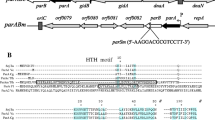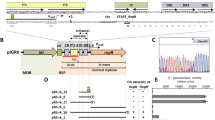Summary
Replication and incompatibility properties in Escherichia coli of DNA segments from the replication origin region of plasmid RK2 have been investigated. A 393 bp HpaII fragment, derived from the region of the RK2 origin of replication, carries an active origin when essential RK2 encoded functions are provided in trans and will form a mini RK2 replicon when linked to a non-replicating selective fragment. This small ori RK2 plasmid cannot stably coexist with other functional RK2 replicons and is thus ‘incompatible” with RK2 replicons. However, the 393 bp ori RK2 segment when cloned into a high copy number plasmid, where plasmid maintenance is no longer dependent on ori RK2, does not interfere with maintenance of a resident RK2 replicon. This is in contrast to larger segments from the origin region that, when cloned at high copy number, cause the loss of a resident RK2 replicon. The apparent ability of the small HpaII oriRK2 plasmid to displace resident RK2 replicons may indicate the turning on of one incompatibility mechanism only when replication from ori RK2is required or may simply reflect the strong selective pressure for establishment of the incoming ori RK2 plasmid and poor ability of the HpaII ori RK2 plasmid to replicate in the presence of another RK2 replicon. The incompatibility expressed by the functional HpaII ori RK2 may be designated inc 1. The activity of a segment of RK2, cloned at high copy number, to eliminate a resident RK2 plasmid has been localized to a region of RK2 DNA, designated the inc 2 region, to distinguish it from inc 1, above, that overlaps but does not coincide with the 393 bp HpaII ori RK2. This inc 2 region also appears to be involved in segregation of RK2 derivatives since removal of a portion of this region results in both higher copy number and increased instability of the RK2 derivative. In addition to defining the region of the RK2 origin of replication, these results indicate that the ability to eliminate a resident RK2 replicon can be expressed by fragments, cloned at high copy number, that do not contain the complete ori RK2. Also, only part of the inc 2 region that appears to be responsible for efficient elimination of RK2 replicons by fragments cloned at high copy number is required for ori RK2.
Similar content being viewed by others
References
Bahl CP, Marians KJ, Wu R, Stawinsky J, Narang SA (1976) A general method for inserting specific DNA sequence into cloning vehicles. Gene 1:81–92
Beringer JE (1974) R factor transfer in Rhizobium leguminosarum. J Gen Microbiol 84:188–198
Blattner FR, Williams BG, Blechl AE, Denniston-Thompson K, Faber HE, Furlong L.-A., Grunwald DJ, Kiefer DO, Moore DD, Schumm JW, Sheldon EL, Smithies O (1977) Charon phages: safer derivatives of bacteriophage lambda for DNA cloning. Science 196:161–169
Bolivar F, Rodriguez RL, Greene PJ, Betlach M, Heyneker HL, Boyer HW, Crosa JH, Falkow S (1977) Construction and characterization of new cloning vehicles. II. A multipurpose cloning system. Gene 2:95–113
Burkhardt H.-J, Riess A and Puhler A (1979) Relationship of group P-1 plasmids revealed by heteroduplex experiments: RP1, RP4, R68 and RK2 are identical. J Gen Microbiol 114:341–348
Change ACY, Cohen SN (1978) Construction and characterization of amplifiable multicopy DNA cloning vehicles derived from the P15A cryptic miniplasmid. J Bacteriol 134:1141–1156
Datta N, Hedges RW (1972) Host range of R factors. J Gen Microbiol 70:453–460
Figurski D, Meyer R, Miller DS, Helinski DR (1976) Generation in vitro of deletions in the broad host range plasmid RK2 using phage Mu insertions and a restriction endonuclease. Gene 1:107–119
Figurski D, Helinski DR (1979) Replication of an, origin containing derivative of plasmid RK2 dependent on a plasmid function provided in trans. Proc Natl Acad Sci USA 76:1648–1652
Greene PJ, Betlach M, Goodman HM, Boyer HW (1974) The EcoRI restriction endonuclease. In: Wickner RB (ed) Methods in molecular biology, vol 7. M. Dekker, New York, p 87
Greene PJ, Heyneker HL, Bolivas F, Rodriguez RL, Betlach MC, Covarrubias AA, Backman K, Russel DJ, Tact R, Boyer HW (1978) A general method for the purification of restriction enzymes. Nucleic Acid Res 5, 2373–2380
Grossman LI, Watson R, Vinograd J (1974) Restricted uptake of ethidium bromide and propidium iodide by denatured closed circular DNA in buoyant caesium chloride. J Mol Biol 86:271–283
Ingram LC, Richmond MH, Sykes RB 61973) Molecular characterization of the R factors implicated in the carbenicillin resistance of a sequence of Pseudomonas aeruginosa strains isolated from bruns. Antimicrob Ag Chemother 3:279–288
Kahn M, Kolter R, Thomas C, Figurski D, Meyer R, Remaut E, Helinski DR (1979) Plasmid cloning vehicles derived from plasmids ColE1, F., R6K, and RK2. Methods in Enzymology 68:368–380
Kolter R, Helinski DR (1978) Construction of plasmid R6K derivatives in vitro: Characterization of the R6K replication region. Plasmid 1:571–580
Kolter R, Inuzuka M, Helinski DR (1978) Trans-complementation dependent replication of low molecular weight origin fragment from plasmid R6K. Cell 15:1199–1208
Lusky M, Hobom G (1979) Inceptor and origin of DNA replication in lambdoid coliphages. I. The DNA minimal replication system. Gene 6:137–172
Lusky M, Hobom G (1979) Inceptor and origin of DNA replication in lambdoid coliphages. II. The DNA maximal replication system. Gene 6:173–197
Maxam AM, Gilbert W (1977) A new method for sequencing DNA. Proc Natl Acad Sci USA 74:560–564
Messer W, Meijer M, Bergmans HEN, Hansen FG, Von Meyenberg K, Beck E, Schaller H (1979) Origin of replication, oriC or the Escherichia coli K12 chromosome: nucleotide sequence. Cold Spring Harbor Symp Quant Biol 43:139–145
Meyer RJ, Helinski DR (1977) Unidirectional replication of the P-group plasmid RK2. Biochim Biophys Acta 478:109–113
Meyer R, Figurski D, Helinski DR (1977) Physical and genetic studies with restriction endonucleases on the broad host range plasmid RK2. Mol Gen Genet 152:129–135
Oka A, Nomura N, Morita M, Sugisaki H, Sugimoto K, Takanami M (1979) Nucleotide sequence of small ColE1 derivatives: Structure of the regions essential for autonomous replication and colicin E1 immunity. Mol Gen Genet 1172 11151–159
Olsen RH, Shipley P (1973) Host range and properties of the Pseudomonas aeruginosa R factor R1822. J Bacteriol 113:772–789
Stalker DM, Thomas CM, Helinski DR (1981) Nucleotide sequence of the region of the origin of replication of the broad host range plasmid RK2. Mol Gen Genet 181:8–12
So M, Gill R, Falkow S (1977) The generation of a ColE1-Apr cloning vehicle which allows detection of inserted DNA. Mol Gen Genet 142:239–249
Sutcliffe G (1979) Complete nucleotide sequence of the Escherichia coli plasmid pBR322. Cold Spring Harb Symp Quant Biol 43:77–90
Thomas CM, Meyer R, Helinski DR (1980) Regions of the broad host range plasmid RK2 essential for replication and maintenance. J Bacteriol 141:213–222
Yasuda S, Hirota Y (1977) Cloning and mapping of the replication origin of Escherichia coli. Proc Natl Acad Sci USA 74:5458–5462
Zyskind JW, Deen LT, Smith DW (1979) Isolation and mapping of plasmids containing the Salmonella typhimurium origin of DNA replication. Proc Natl. Acad Sci USA 76:3097–3101
Author information
Authors and Affiliations
Additional information
Communicated by D. Sherrat
Rights and permissions
About this article
Cite this article
Thomas, C.M., Stalker, D.M. & Helinski, D.R. Replication and incompatibility properties of segments of the origin region of replication of the broad host range plasmid RK2. Mol Gen Genet 181, 1–7 (1981). https://doi.org/10.1007/BF00338996
Received:
Issue Date:
DOI: https://doi.org/10.1007/BF00338996




